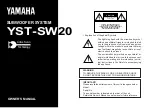
CONNECTIONS AND CONTROLS
CAUTION: Ensure that the subwoofer is unplugged from the AC wall outlet
before making any connections.
“LINE IN” Connection
- Most of today’s surround receivers (and pre-amplifiers)
have a line level subwoofer output labeled Subwoofer Pre Out, Sub Out, SW
Out, etc. If you have this output, connect one end of a subwoofer cable to it
and connect the other end of the cable into the subwoofer line input labeled
LEFT/LFE. This connection allows the subwoofer to operate with both music
and surround sound movies (refer to your receiver manual). In absence of a
subwoofer output on your receiver, as an alternative hookup, you can connect
Left and Right channel Pre-Amp Outputs from your receiver (if provided) to the
Left/LFE and Right input on the subwoofer.
“LOWPASS” Control
- The crossover point chosen determines where low bass
frequencies are “handed off” from the speakers to the subwoofer. If setting the
crossover point in the receiver, turn the Lowpass Filter knob on the subwoofer
to the farthest point right (160Hz). Set the crossover point based on the size
of the main left/right speakers you are using in the system. As a general rule,
for larger, floorstanding speakers, set the crossover point between 50Hz-90Hz.
If using small bookshelf or “satellite” speakers for the mains, set the crossover
point between 90Hz-150Hz. The smaller the speaker, the higher the setting until
the bass frequencies blend well between the speakers and your subwoofer once
your system is completely hooked up. If your receiver does not have a crossover
point setting, set the Lowpass Filter on the subwoofer instead within the same
recommended settings (see receiver manual for additional speaker setup info).
Level
- If your subwoofer is connected to a Subwoofer Output of a surround
receiver, first set the subwoofer volume level control in the receiver to the “half
way” or “0 dB” position. Then increase the volume (or gain) of the subwoofer up
until the subwoofer’s volume level matches the output of your main speakers.
After this setup is completed, the volume control on your system’s main amplifier
or pre-amplifier will be the volume control for both your subwoofer and speakers
together. If your subwoofer is connected to the L/R Pre-Amp Outputs of a receiver
there will be no subwoofer volume in that receiver to set before setting the
subwoofer’s gain control.
“PHASE” 0/180
– This control is used to acoustically match the subwoofer’s
output to your main speakers. Select the position either 0˚ or 180˚ in which your
subwoofer has more output at the listening position.
Off/Auto/On
– When this switch is in the “ON/AUTO” position, the subwoofer
will automatically turn “on” when it senses a signal. It will automatically go into
“standby mode” after 15-20 minutes with no signal. When this switch is in the
“OFF” position, the subwoofer will remain “off” until the switch is manually turned
back to the “ON/AUTO” position.
Power LED indicator
- Located on the front baffle, this LED indicates the
operating status of the built-in amplifier. The LED will light green when the
amplifier is on and receiving a signal. If the LED is dark and not lit, the amplifier
is off. For more information on the controls mentioned in this manual and on
bass management, see your dealer or visit www.klipsch.com





































